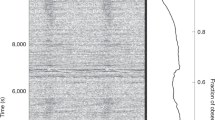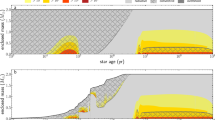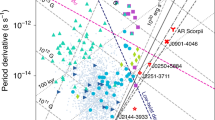Abstract
THE pulsar NP 0532 has been identified with the central star of the Crab Nebula1, the famous remnant of the “Chinese” supernova of 1054. There is thus a prima facie case for a systematic search through ancient Chinese records for similar coincidences. The following argument can be put forward against this undertaking. The pulsar NP 0532 has by far the shortest known period and, further, its period is increasing2. If all pulsars begin their existence with about the same period and if the period always increases secularly, then the much longer periods of the other pulsars imply that they were formed long before historical times. But this argument is, of course, based on only one single instance. If the radio sources OON 6A and CTB 41 associated respectively with Tycho's supernova of 1572 and Kepler's of 1604 are indeed pulsars with periods even shorter than that of NP 0532, then the argument would be compelling, but, as things are, it is better to adopt a more flexible stand and assume that the period of a pulsar is not a function of its age only and that at least some of the other known pulsars could have been formed within the last two or three thousand years.
This is a preview of subscription content, access via your institution
Access options
Subscribe to this journal
Receive 51 print issues and online access
$199.00 per year
only $3.90 per issue
Buy this article
- Purchase on Springer Link
- Instant access to full article PDF
Prices may be subject to local taxes which are calculated during checkout
Similar content being viewed by others
References
Cocke, W. J., Disney, M. J., and Taylor, D. J., Nature, 221, 525 (1969).
Richards, D., IAU Circ. No. 2114 (1968).
Hsi, Tse-Tsung, Acta Astronomica Sinica, 3, 183 (1955); English trans., Smithson. Contr. Astrophys., 2, 109 (1958).
Xi, Ze-zong and Bo, Shu-ren, Acta Astronomica Sinica, 13, 1 (1965); English trans., NASA TT F-388 (1966).
Ho Peng Yoke, Vistas in Astronomy, 5, 127 (1962).
Chao, Y. R., and Yang, L. S., Concise Dictionary of Spoken Chinese (Harvard Univ. Press, 1952).
Williams, J., Observations of Comets extracted from the Chinese Annals (London, 1871).
Howard, W. E., and Maran, S. P., Astrophys. J. Suppl., 101 (1968).
Braes, L. L. E., and Hovenier, J. W., Bull. Astron. Inst. Netherlands, 18, 294 (1966).
Author information
Authors and Affiliations
Rights and permissions
About this article
Cite this article
KIANG, T. Possible Dates of Birth of Pulsars from Ancient Chinese Records. Nature 223, 599–601 (1969). https://doi.org/10.1038/223599a0
Received:
Issue Date:
DOI: https://doi.org/10.1038/223599a0
This article is cited by
-
Supernova of AD 1437
Nature (1969)
Comments
By submitting a comment you agree to abide by our Terms and Community Guidelines. If you find something abusive or that does not comply with our terms or guidelines please flag it as inappropriate.



